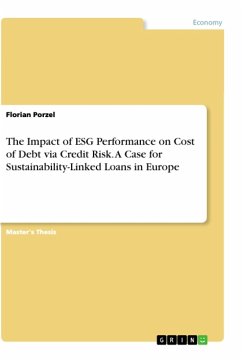Master's Thesis from the year 2005 in the subject Business economics - Investment and Finance, grade: 1,7, ESC Dijon Bourgogne - Burgundy School of Business (Studiengang Master of Science in European Business Administration), language: English, abstract: Inhaltsangabe:Abstract:
Recently business magazines and newspapers have reported regularely about settled NPL deals. NPL is the abbreviation for a non-performing loan and simply describes a situation in which the debtor stopped complying to the terms agreed upon with the lender. Depending on the specific credit terms, the borrower has to pay interest and to repay the principle at a certain time. If this does not happen at a specific time the lender will demand the debtor to stick to the agreed terms and finally, in the event that the debtor does not change his or her behaviour, terminate the underlying contract.
At what specific point in this process the loan should be qualified as a non-performing loan is not standardized. The range of past due periods varies from 30 days, over 90 days, to even 180 days. Neither accounting rules nor supervisory law specify yet under which conditions a financial institution has to classify certain loans as non-performing loans. However, this will change with the enforcement of Basel II, and also thanks to international distressed debt investors which demand for global standards.
From time to time financial institutions amass huge stocks of these loans which finally leads to a wave of NPL sales. The market for NPL s evolves and is active for three to five years. After resolving the stock of NPL s it breaks down and stays relatively inactive for a longer time before it might develop again. Beside this time-related feature, a geographic pattern can be detected. The market does not evolve at the same time all around the world, but moves from one country or economic zone to the other.
Right now, Germany is the most active market in Europe. The question is why. The sale of NPL s belongs neither for mortgage banks nor for commercial banks to their ordinary business. On the contrary, these banks are selling part of their core business the credit business. Of course defaulting debtors are not the most attractive ones for banks, and therefore who would to question the bank that wants to get rid of them.
On the other hand banks dispose of traditional instruments to deal with these customers. The work-out department is usually in charge of collecting receivables and also the transfer of the respective receivables to debt-collecting agencies is a long exercised practice among banks. Are these traditional means no longer able to deal with the indubitable tremendous stock on NPL s in German banks and will the outsourcing wave reach part of every banks back office?
Many decision-makers in the banking sector are wondering about the mass of offerings and inquiries from potential buyers or intermediaries. Without any doubt the German market is a seller market at the moment. Aside from the banks which have no choice but to sell part of their assets in order to escape insolvency, the question remains whether this is a good opportunity for banks to get rid of some of their bad customers or if this is just an ordinary management hype which results in costly decisions. Taking the intended profit margin of some well-known NPL buyers into account, some doubts about the attractiveness of a sale from a banks point of view might arise.
After giving a picture of the current market situation in Germany including its participants and the regulatory framework for the transactions, the focus is put on the banks point of view. Are there any countable advantages for a selling bank?
Recently settled transactions have proved that the price expectations differ largely from the bids. Is there any hidden value which could be extracted by the sale of NPL s and therefore generate potential for price negoti...
Hinweis: Dieser Artikel kann nur an eine deutsche Lieferadresse ausgeliefert werden.
Recently business magazines and newspapers have reported regularely about settled NPL deals. NPL is the abbreviation for a non-performing loan and simply describes a situation in which the debtor stopped complying to the terms agreed upon with the lender. Depending on the specific credit terms, the borrower has to pay interest and to repay the principle at a certain time. If this does not happen at a specific time the lender will demand the debtor to stick to the agreed terms and finally, in the event that the debtor does not change his or her behaviour, terminate the underlying contract.
At what specific point in this process the loan should be qualified as a non-performing loan is not standardized. The range of past due periods varies from 30 days, over 90 days, to even 180 days. Neither accounting rules nor supervisory law specify yet under which conditions a financial institution has to classify certain loans as non-performing loans. However, this will change with the enforcement of Basel II, and also thanks to international distressed debt investors which demand for global standards.
From time to time financial institutions amass huge stocks of these loans which finally leads to a wave of NPL sales. The market for NPL s evolves and is active for three to five years. After resolving the stock of NPL s it breaks down and stays relatively inactive for a longer time before it might develop again. Beside this time-related feature, a geographic pattern can be detected. The market does not evolve at the same time all around the world, but moves from one country or economic zone to the other.
Right now, Germany is the most active market in Europe. The question is why. The sale of NPL s belongs neither for mortgage banks nor for commercial banks to their ordinary business. On the contrary, these banks are selling part of their core business the credit business. Of course defaulting debtors are not the most attractive ones for banks, and therefore who would to question the bank that wants to get rid of them.
On the other hand banks dispose of traditional instruments to deal with these customers. The work-out department is usually in charge of collecting receivables and also the transfer of the respective receivables to debt-collecting agencies is a long exercised practice among banks. Are these traditional means no longer able to deal with the indubitable tremendous stock on NPL s in German banks and will the outsourcing wave reach part of every banks back office?
Many decision-makers in the banking sector are wondering about the mass of offerings and inquiries from potential buyers or intermediaries. Without any doubt the German market is a seller market at the moment. Aside from the banks which have no choice but to sell part of their assets in order to escape insolvency, the question remains whether this is a good opportunity for banks to get rid of some of their bad customers or if this is just an ordinary management hype which results in costly decisions. Taking the intended profit margin of some well-known NPL buyers into account, some doubts about the attractiveness of a sale from a banks point of view might arise.
After giving a picture of the current market situation in Germany including its participants and the regulatory framework for the transactions, the focus is put on the banks point of view. Are there any countable advantages for a selling bank?
Recently settled transactions have proved that the price expectations differ largely from the bids. Is there any hidden value which could be extracted by the sale of NPL s and therefore generate potential for price negoti...
Hinweis: Dieser Artikel kann nur an eine deutsche Lieferadresse ausgeliefert werden.








